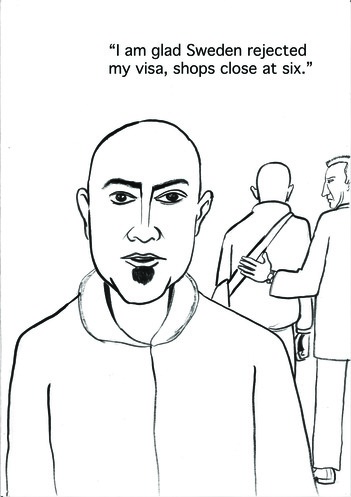
metroZones
Berlin Field Recodings.
Mapping Along the Refugee Complex
IN THE SYSTEM
SUR PLACE
WIEDERAUFNAHMEPROBE
Versuche einer Kartierung städtischen Handelns
Attempting to Map Urban Action
Nach einem langen Protestmarsch quer durch Deutschland und Hungerstreiks am Brandenburger Tor etablierten Refugees auf dem Kreuzberger Oranienplatz im Herbst 2012 ein Protestcamp. Diese Raumnahme – die immerhin eineinhalb Jahre
währte – nahm metroZones zum Anlass, die Fragen nach urbaner Teilhabe und Citizenship in einem künstlerischen Rechercheprojekt neu zu stellen.
Dabei verstehen wir die Mobilisierung der Geflüchteten als städtisches
Handeln, das unsere Stadtgesellschaften in neuer Weise herausfordert. Wie bewegen sich Geflüchtete in einer Stadt (wie beispielsweise Berlin), wie organisieren sie ihr Durchkommen? Wo nehmen sie sich Räume, welche Bilder erzeugen
sie von sich, welche Fragen stellen sie an die Stadt, welche Rechte erkämpfen sie sich?
In Zusammenarbeit mit den Künstler*nnen Sarnath Banerjee, Christian Hanussek und Diana Lucas-Drogan sowie einer Vielzahl von Gesprächspartner*innen
entwickelte metroZones eine dreiteilige Serie von Mappings, die – in sehr verschiedenen Handschriften und Betonungen – urbane Erfahrungen von Geflüchteten thematisieren. Dazu gehören ihre Erfahrungen mit Rechten und Räumen,
mit Alltagsorganisation und Ausnahmezuständen wie auch die Frage nach der Handlungsmacht (agency) von Einzelnen aber auch von Kollektiven.
In the fall of 2012 following a long protest march across Germany and hunger strikes at the Brandenburg Gate refugees established a protest camp on the Oranienplatz in Kreuzberg. metroZones rose to the occasion of this occupation
of space—which lasted after all one and a half years—and reintroduced the issues of urban participation and citizenship in an artistic research project.
In this process we consider the mobilisation of the refugees
as urban action (städtisches Handeln) that challenges our urban societies in a new way. How do refugees move in a city (such as Berlin), and how do they manage (to pull through)? Where do they occupy spaces and what are the
images they generate of themselves? What are the questions refugees pose to the city and what are the rights they are fighting for?
In cooperation with the artists Sarnath Banerjee, Christian Hanussek and Diana Lucas-Drogan
as well as a variety of additional interlocutors metroZones developed a tripartite series of mappings, which —in rather different scripts and accentuations— address urban experiences of refugees. That includes their experiences
with rights and spaces, with organising the daily routine and states of emergency as well as the agency of both individuals as well as collectives.
Mapping
Mapping
Was kann es bedeuten, eine Stadt neu zu kodieren? Mapping verstehen wir nicht als reines Dokumentieren oder Aufzeigen von etwas bereits Vorhandenem. Wir gehen vielmehr davon aus, dass beim Sprechen, Zeichnen und Betrachten Verknüpfungen entstehen und Dinge sichtbar werden, die auf anderen Wegen (wie der fotografischen Rekonstruktion, in textbasierten Erzählungen) nicht ohne weiteres erkennbar sind. Und es handelt sich bei den entstandenen Arbeiten auch nicht um Kartierungen im engeren Sinne, sondern eher um einen Modus des Auf-Zeichnens im weiten Sinne: von Erinnertem und Erlebtem, von Imaginierten, Verstandenem und miteinander Verknüpften. Schließlich geht es niemals um die eine Karte; Mapping ist ein Prozess. Und zwar einer voller Ambivalenzen. Denn zu fragen ist immer auch: Wem nützt das Kartieren als Datensammlung? Was wird sichtbar und lokalisiert – und was gerade nicht? Unseren »Kartierungen« ging eine dreiteilige Recherche voraus, in der Refugees und andere Akteure nach ihren Erfahrungen und Überlegungen, Erinnerungen und Wunschproduktionen befragt wurden und diese zum Teil selber aufzeichneten.
What could it mean to recode a city? We do not consider mapping as a matter of merely documenting or indicating something that already exists. Instead we proceed from the assumption that the act of talking, drawing and reading creates correlations, rendering things visible that are not readily discernible by other means (such as photographic reconstruction or textual narratives). Likewise the works that emerged are no mappings in the stricter sense but rather a mode of reco(r)ding in the broadest sense: things remembered and experienced, imagined, understood and intertwined. This is never about the one map—mapping is, after all, a process and at that, a very ambiguous one. Because one must always consider: who benefits from maps in terms of a data collection? And what is visible and being located—and what not? Our mappings were preceded by a research in three sections, in which refugees and other actors were interviewed about their experiences and reflections, memories und desires, and sketched these in parts themselves.
Das Projekt
The Project
Die Mappings sind der Versuch einer – im weitesten Sinne – (karto)grafischen Übersetzung der dabei zutage tretenden narrativen, räumlichen und diskursiven Konstellationen. In einer Art Trilogie erzählen sie von verschiedenen Dimensionen dessen, was wir Refugee-Komplex nennen: Die Bildserie »In the system« kreist um Bürokratisierung, Entrechtung, Alltagstaktiken, Überlebensstrategien und Formen des Widerstands; die mehrstimmige Kartierung »Sur place« rekonstruiert urbane Raumnahmen und Alltagsorganisation unter Ausnahmebedingungen; die mehrschichtige Notation »Wiederaufnahmeprobe« zeichnet das Ringen um ein selbstorganisiertes Zentrum von Refugees in der Stadt nach – und betont damit, nachdem alle Verhandlungen gescheitert sind, zugleich die Relevanz eines solchen Ortes. Ausgestellt wurden Zeichnungen unter dem Titel Berlin Field Recodings im Rahmen des 2. Herbstsalons des Berliner Maxim Gorki Theaters, vom 13. bis zum 29. November 2015. Vorausgegangen waren zwei metroZones-saloons an gleichem Ort, im Februar und September 2015. In einem weiteren Salon am 21. Dezember wurden die kollaborativ produzierten Zeichnungen, deren Befunde und Methoden zuvor mit den Projektbeteiligten diskutiert worden waren, öffentlich zur Diskussion gestellt und einer gemeinsame Re-Lektüre unterzogen: Eingeladen dazu waren unter die anderem Aktivist*innen Napuli Paul Langa und Muhammad Asif Syed sowie die Künstler Christoph Schäfer und Peter Spillmann.
The exhibited mappings are the attempt of a (carto)graphic translation of the narrative, spatial and discursive constellations emerging in the process. In a kind of trilogy they narrate the different dimensions of that what we call “Refugee Complex”: the image series »In the system« revolves around bureaucratization, deprivation of rights, daily life tactics, survival strategies, and forms of resistance; the polyphonic mapping »Sur place« reconstructs urban occupation of space and organising everyday life under exceptional circumstances; the multi-layered notation »Rehearsing Revival« traces the struggle for a self-organised refugee centre in the city—emphasizing in doing so the relevance of such a space after all negotiations failed. The drawings were exhibited under the title Berlin Field Recodings within the scope of the second Fall Salon of the Berlin Maxim Gorki theatre from November 13th to 29th 2015. Two metroZones salons at the same location in February and September 2015 preceded this. In a further salon on December 21st the collaboratively produced drawings —whose findings and methods had been previously discussed with the ones involved in the project— were open to public debate and subject of a shared re-lecture. Invitees included the activists Napuli Paul Langa and Muhammad Asif Syed as well as the artists Christoph Schäfer and Peter Spillmann.
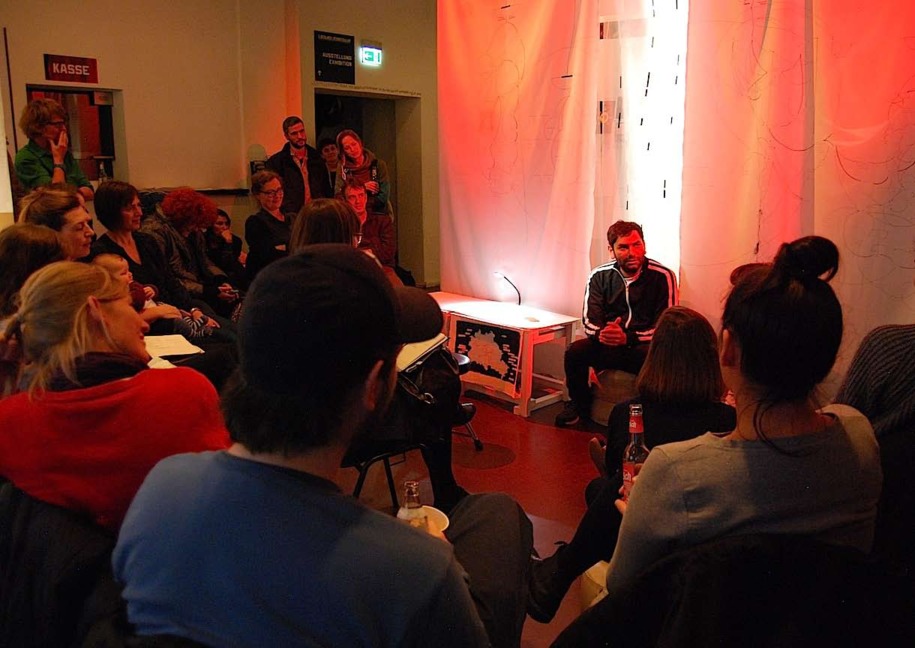
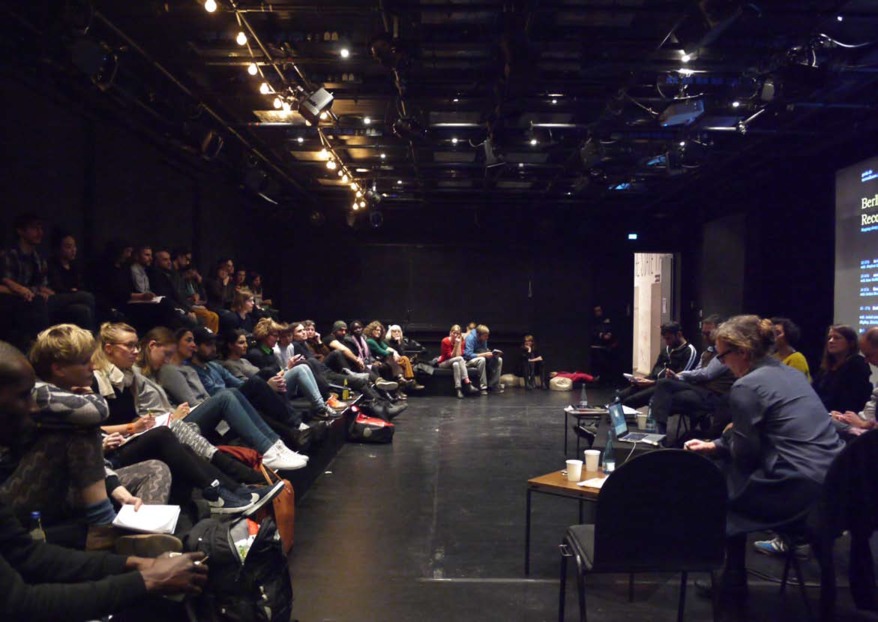
In the System
Die Zeichnungen von Sarnath Banerjee beruhen auf Gesprächen mit vier Geflüchteten über ihre Erfahrungen mit der Asylbürokratie in der EU und in Deutschland sowie mit den Heimen, in denen sie zu wohnen gezwungen waren. Im Wesentlichen
ging es dabei um alltägliche Taktiken und Strategien, mit denen Fidelia, Omar, Mohammed und Muhammed Asif Syed gemeinsam mit anderen Geflüchteten Widerstand gegen ihre Entrechtung geleistet haben.
Kuratiert wurde »In
the system« für metroZones von Stephan Lanz. Beteiligt waren außer den Genannten, die es zum Teil vorzogen, nicht mit ihrem (ganzen) Namen bezeichnet zu werden, Barbara Wessel und Anna Haucke.
The drawings of Sarnath Banerjee are based upon conversations with four refugees about their experiences with the immigration bureaucracy for asylum seekers in the EU and Germany, including the accommodations/hostels, in which
they were forced to live. This concerned basically the everyday tactics and strategies Fidelia, Omar, Mohammed und Muhammed Asif Syed employed together with other refugees in putting up resistance against their deprivation
of rights.
Stephan Lanz curated »In the System« on behalf of metroZones. Barbara Wessel und Anna Haucke were involved in addition to the afore-mentioned, who largely preferred not to be mentioned with their full names.

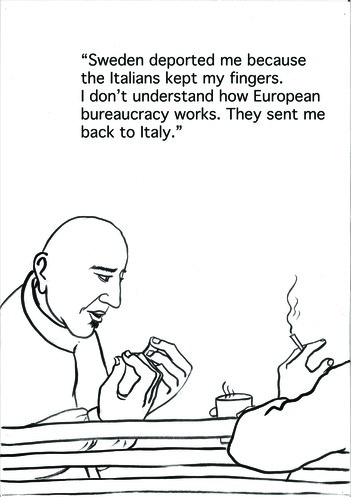
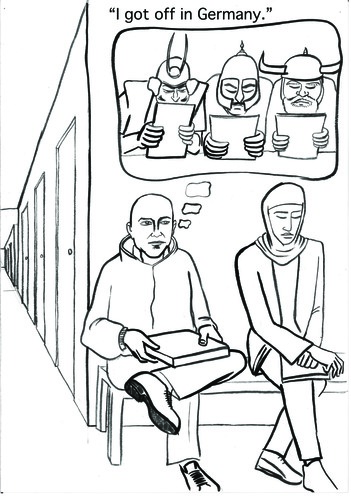
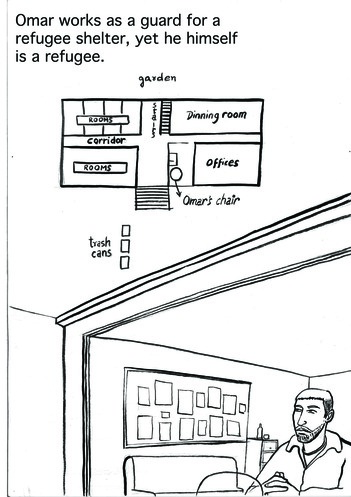
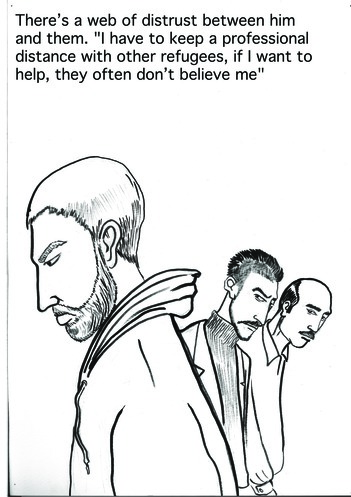
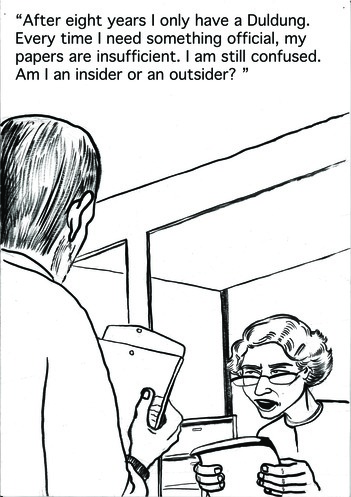

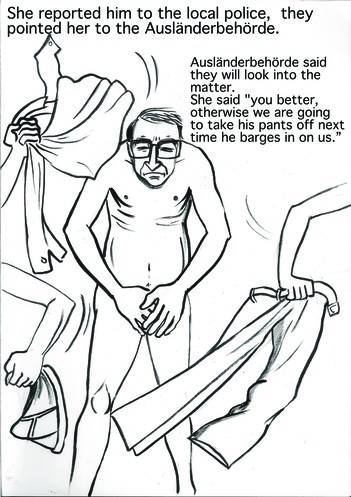
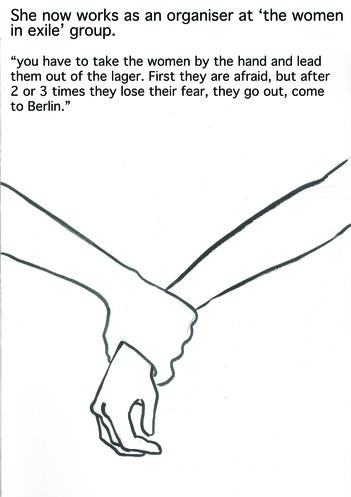
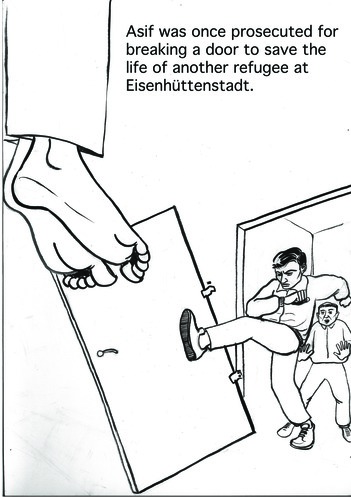
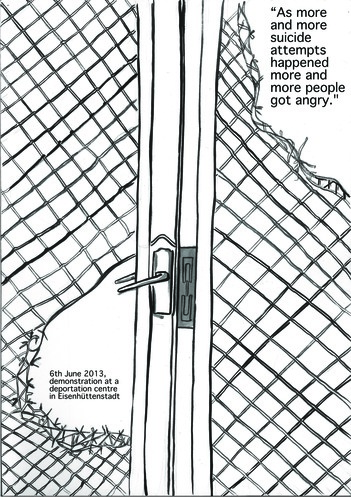
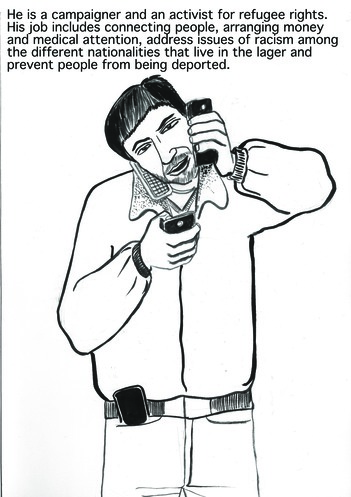
Sur place
Die Karten beruhen auf den Erinnerungen von fünf Geflüchteten, die mit uns die Besetzung des Oranienplatzes (Oktober 2012 bis April 2014) wie auch der ehemaligen Gerhard-Hauptmann-Schule in Gesprächen und Zeichnungen rekonstruierten.
Wir haben diese Fragmente und Erzählungen in einem Mappingversuch und einer damit verlinkten Textcollage zusammengeführt; die fünf Erzählerstimmen sind in verschiedenen Farben gekennzeichnet. Auch die zeitliche Entwicklung
der Oranienplatz-Besetzung ist durch Farben dargestellt: Von der sogenannten »ersten Generation« in Schwarz, die »zweite Generation« in Blau, bis zum Kunstprojekt »Haus der 28 Türen« in Rot und die »7 x 11 Meter Fläche«, die
den Aktivisten für einen künftigen Projektraum zugesagt ist, in Orange.
Kuratiert wurde die Rekonstruktion für metroZones von Anne Huffschmid und Christian Hanussek (Zeichnung); beteiligt waren Jelka Plata und Laura
Klatt, Napuli Paul Langa, Muhammed Lamin Jadama, Amdi Niang, Oumar Asouman und Ousmane Fouha.
The maps are based upon the memories of five fugitive people, who reconstructed together with us the occupations of both the Kreuzberg Oranienplatz (from October 2012 to April 2014) as well as the former Gerhard Hauptmann School
in conversations and drawings. By way of mapping we merged these fragments and narrations with an accompanying text collage in which the five narrator voices are marked in different colours. Likewise the temporal development
of the Oranienplatz occupation is depicted by colours: ranging from the so-called »first generation« in black over the »second generation« in blue to the »House of 28 Doors« art project in red, and the »7 x 11 metres surface/space«—that
had been promised to the activists as a future project space—in orange.
Anne Huffschmid and Christian Hanussek (drawing) curated the reconstruction for metroZones with the participation of Jelka Plata and Laura Klatt,
Napuli Paul Langa, Muhammed Lamin Jadama, Amdi Niang, Oumar Asouman and Ousmane Fouha.
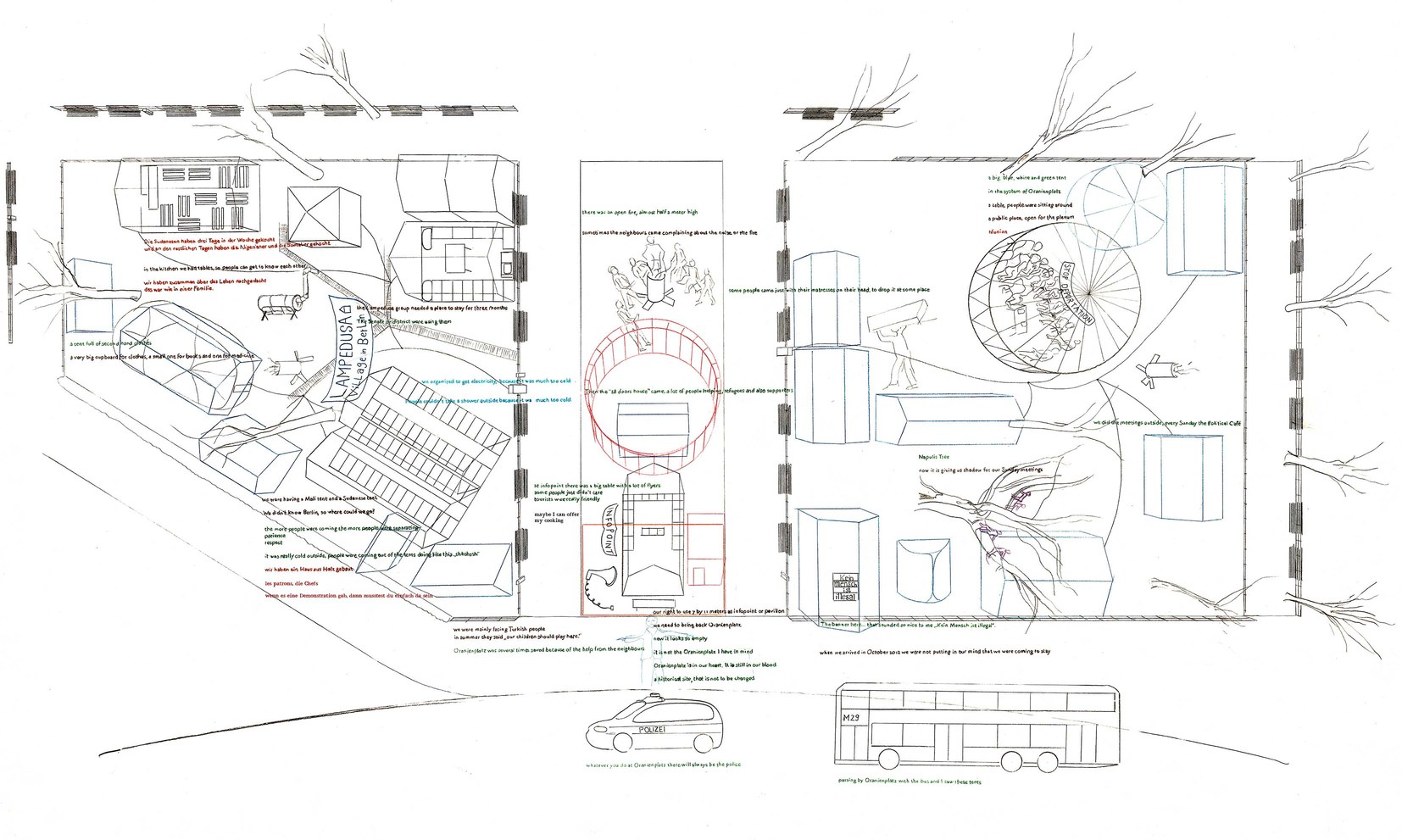 close
close
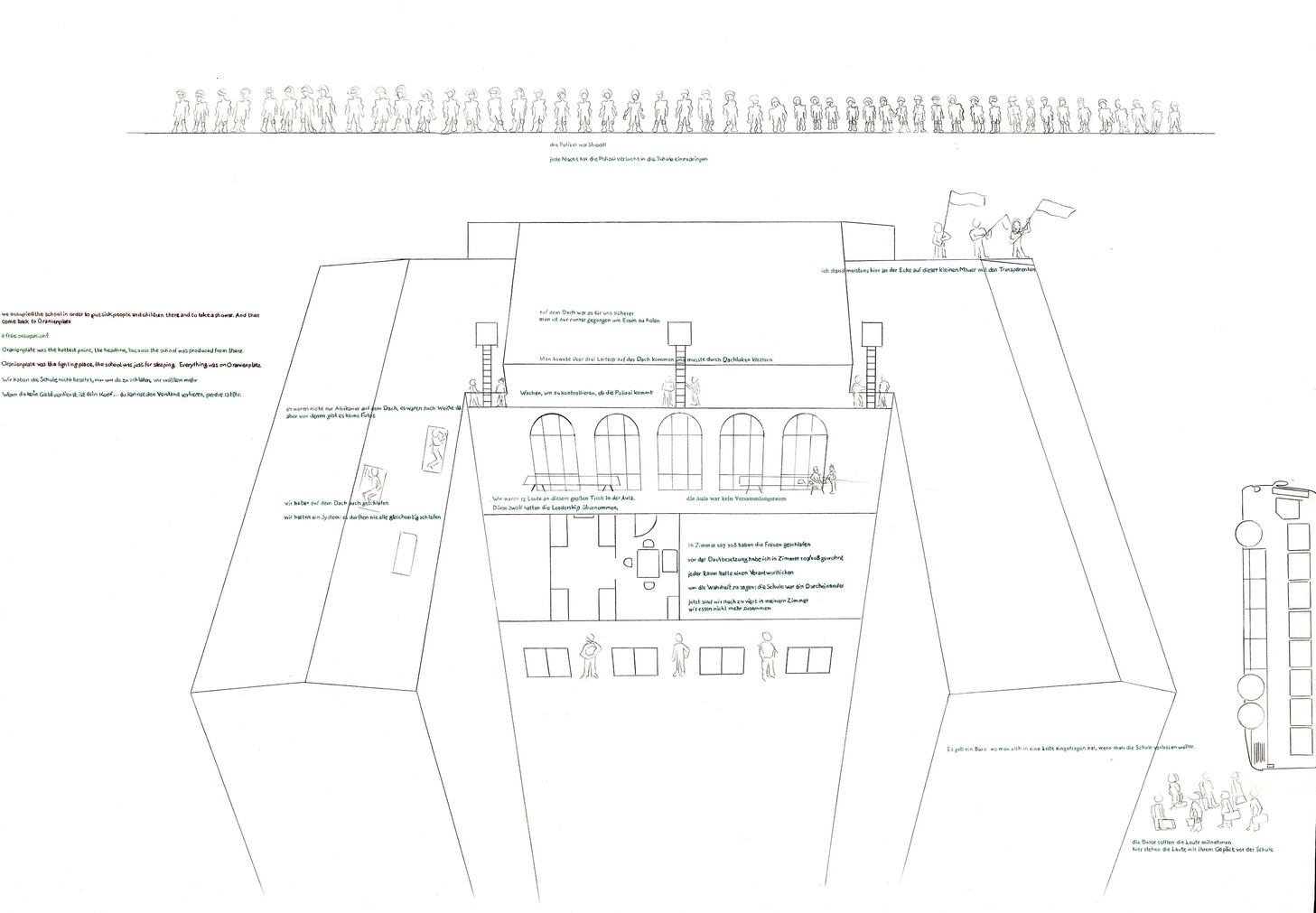 close
close
Wiederaufnahmeprobe
Die mehrschichtige Notation Wiederaufnahmeprobe stellt wiederholt die Frage nach einem selbstorganisierten Center von Refugees in der Stadt. Erinnert sei an die mühsam zwischen städtischen VertreterInnen und den Refugees ausgehandelten
Regeln um die seit 2013 von Refugees bewohnte Gerhart-Hauptmann-Schule sowie die Umstände ihrer gewaltsamen Räumung im Juni 2014. Die achtzehn Monate Besetzung der ehemaligen Schule als gewaltsame Öffnung des Gemeinwesens zu
denken heißt ja nicht nur, öffentliche Güter (ein leerstehendes Gebäude) in öffentlichen Gebrauch (Nutzung als Wohn- und Versammlungsräume) zu überführen. Sondern es meint auch, den diskursiven Raum zu eröffnen, um einen handfesten
Streit anzuzetteln über die permanenten Verletzungen der Grundrechte.
In Berlin wurden Praxen für eine künftige, post-babylonische Stadtgesellschaft erprobt. Das »Recht auf Stadt« wird sich neue »Gesetze« in einer
gemeinsam zu findenden Sprache schreiben, die von allen für alle verhandelt wird. In einer Stadt von Welt gibt es keinen privilegierten Punkt mehr, von dem aus Entscheidungen zur In- und Exklusion definiert werden könnten,
so dass es nach Balibar »auf dem Boden des Staatsbürgerlichen keine ›zuerst Gekommenen‹ gibt«. Die mit der Hand skizzierten Verträge, zäh ausgehandelt mit VertreterInnen kommunaler Politik, wurden von den Refugees
auf dem Oranienplatz sowie vor der Hauptmann-Schule 2014 demonstrativ in die Kameras gehalten, um Zeugenschaft für diese prekäre Rechts-Schreibung einzufordern. Rasch schon brach die Stadtverwaltung Berlins in schäbiger Ignoranz
ihre mitverfassten Verträge.
In einer dem Theater entnommenen »Wiederaufnahmeprobe« soll dieses Drama noch einmal auf die Bühne gebracht werden, um auszuloten, was hier noch zu ändern wäre. Die verpassten Chancen liegen
auf der Hand. Die damaligen Akteure erinnern sich an die Handlungen in jüngster Vergangenheit. Im Sinne eines Lehrstücks ließe der künstlerische Akt einen anderen Ausgang zu.
Erfahrungen und Überlegungen, Erinnerungen
und Wunschproduktionen werden diskutiert und auf Papier aufgezeichnet. Das Team liest einzelne Gesprächsprotokolle neu und überführt dies in eine neue Kartierung. Dabei wird der Prozess mit seinen Widersprüchen reflektiert,
etwa was die unterschiedlichen Praxen und Wahrnehmungen von Zeitlichkeit betrifft. Die Machthierarchie zwischen dem städtischen Verhandlungs-Vertreter und den diversen BesetzerInnen der Hauptmann-Schule manifestierte sich u.a.
daran, dass der Bezirkspolitiker stets pünktlich auftrat, während die wechselnd sich an den Verhandlungen beteiligenden Refugees anderweitig beschäftig waren.
Wir gehen davon aus, dass beim kollaborativen Sprechen,
Zeichnen und Betrachten Verknüpfungen entstehen und Dinge sichtbar werden, die auf anderen Wegen – in der fotografischen Rekonstruktion, in textlichen Erzählungen, im individuellen künstlerischen Produkt – nicht ohne weiteres
erkennbar sind. So bilden dokumentarische und künstlerische Photographien, Luftaufnahmen oder klassische Karten für uns eine Grundlage zur groben Verortung. Mit Fäden sind diese Dokumente auf leichten Stoffen angeheftet; darüber
fallen weitere Lagen mit kleinteiligen Notaten und durchkreuzen diese. Die Wiederaufnahmeprobe fügt Schicht um Schicht hinzu und baut somit ein mehrlagiges Bühnen-Szenario auf. Zwischen den Säulen als Bühnenportal hängen transparente
und Falten werfende Tücher. Man kann den Vorhang etwas zur Seite schieben oder schräg hinter die kulissenhaften Lagen schauen.
Scheinwerfer tauchen das Szenario in rotes Licht. Ein kleiner Tisch mit niedrigem Hocker
und Leselicht souffliert vom Rand her den notierten Ausgangstext. Auf der Rückseite der Tücher hängen rhizomatische Fäden wie Luftwurzeln heraus und winden sich zum Boden. Backstage wie auch auf der Bühne selbst ist die Verwirrung
groß. In kollektiven Anstrengungen sind rote Fäden zu erkennen. Im gemeinsamen Handeln webt sich ein Narrativ mit hoffentlich wieder offenem Ausgang.
Die Arbeit wurde kuratiert von Jochen Becker/metroZones und Diana
Lucas-Drogan mit Muhammad Asif Syed und Marlene Rudloff sowie in Gesprächen mit dem Refugee-Ausstellungskollektiv We will rise, Caroline Strotmann (Campus Cosmopolis), Sabine Horlitz/Oliver Clemens (An Architektur), Hans Panhoff
(Baustadtrat Friedrichshain-Kreuzberg), Martin Düspohl (Kreuzberg Museum), Irfan X und weitere Refugees des »Lagers« Pankstraße u.a.
The multi-layered notation Re-Rehearsal repeatedly asks for a self-organised refugee centre in the city. Calling to mind the painstakingly agreed regulations between municipal representatives and the refugees concerning the Gerhart
Hauptmann School inhabited since 2013 by refugees as well as the circumstances of its violent eviction in June 2014. Considering the eighteen-months occupation of the former school as forcefully opening polity is not merely
a matter of transferring common goods (an abandoned building) into public usage (use as living and assembly quarters). It also means opening the discursive space so as to instigate a fierce dispute on the permanent violation
of basic rights.
In Practices for a future post-Babylonian urban society have been tested in Berlin. The »right to the city« will be inscribed in new »laws« in a mutually to be developed language that will be negotiated
by everyone for everyone. In a city of the world there will be no more privileged point, from where decisions concerning in- and exclusion will be defined, so that according to Balibar »there will be no ›first comers‹
on the ground of civics.« In 2014 the refugees on Oranienplatz as well as in front of the Gerhart Hauptmann School held the hand-drafted agreements, resolutely negotiated with representatives of local policy, pointedly into
the cameras so as to demand testimony for this precarious spelling of law. And in no time—and sordid ignorance—Berlin's municipality breached the contracts they had co-authored. In a »Re-Rehearsal« derived from theatre this
drama shall be re-enacted on stage so as to explore what could still be changed here. The missed opportunities are obvious. The actors of that time recall the actions of the most recent past. In terms of a Brechtian Lehrstück,
the artistic act would allow a different ending.
Experiences and reflections, memories and desired productions are discussed and recorded on paper. The team re-reads individual interview transcripts and transfers that into a new mapping. In doing so the process
is reflected with its contradictions, such as diverging practices and perceptions regarding temporality. The power hierarchy between the municipal negotiation representative und the various occupants of the Hauptmann School
is, for instance, manifested in the fact that the local politician always appeared on time, whereas the refugees alternately participating in the negotiations were occupied otherwise.
We proceed on the assumption that
collaborative talking, drawing and observing generate links and visualise things that are not readily discernable with other techniques, such as photographic reconstruction, textual narratives, or the individual artistic project.
Hence documentary and artistic photographs, aerial views or classical maps provide us with a basis for a rough localisation. These documents are attached with threads to light textiles; upon them fall further layers with compartmentalized
notations, crossing them. The Re-Rehearsal adds layer by layer thus building a multi-faceted stage scenario. Between the pillars acting as stage portal hang transparent sheets in folds. One can push the curtain a little bit
aside or look diagonally behind the scenic layers.
Spotlights bathe the scenario in red. A small table with a low stool and reading light prompts from the edge of stage the notated source text. Rhizomatic threads stick
out from the back of the sheets like aerial roots, coiling to the ground. Backstage as well as on the proper stage prevails great confusion. In collective efforts red threads can be distinguished. Joint action spins a narrative
with a hopefully re-opened end.
The work has been curated by Jochen Becker/metroZones and Diana Lucas-Drogan with Muhammad Asif Syed and Marlene Rudloff as well as in interviews with the refugee Exposition Collective
We will rise, Caroline Strotmann (Campus Cosmopolis), Sabine Horlitz/Oliver Clemens (An Architektur), Hans Panhoff (town councillor for public works in Friedrichshain-Kreuzberg), Martin Düspohl (Kreuzberg Museum), Irfan X and
other refugees from the Pankstraße »camp«, and others.
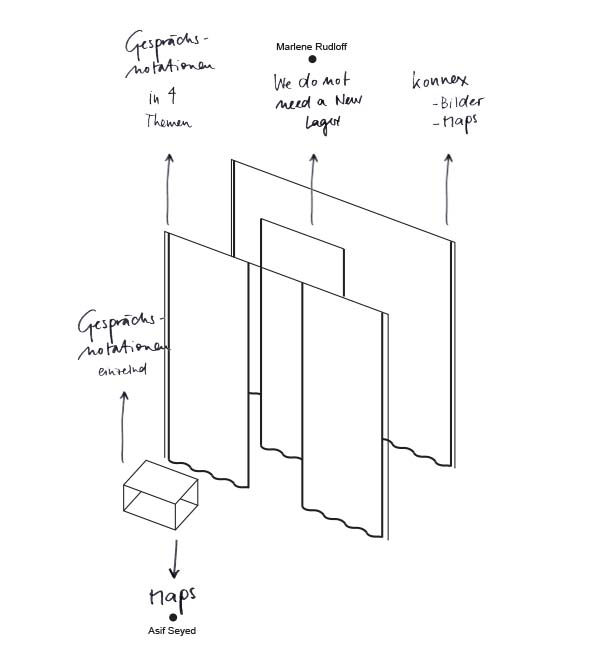


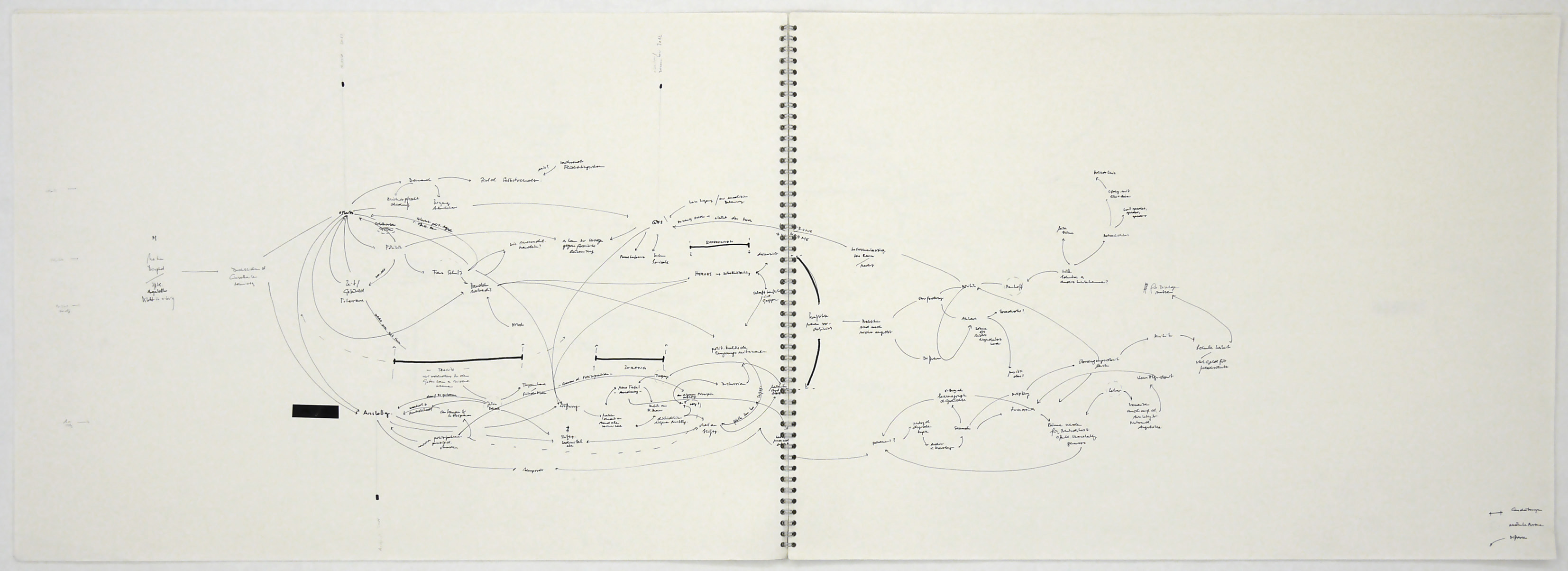
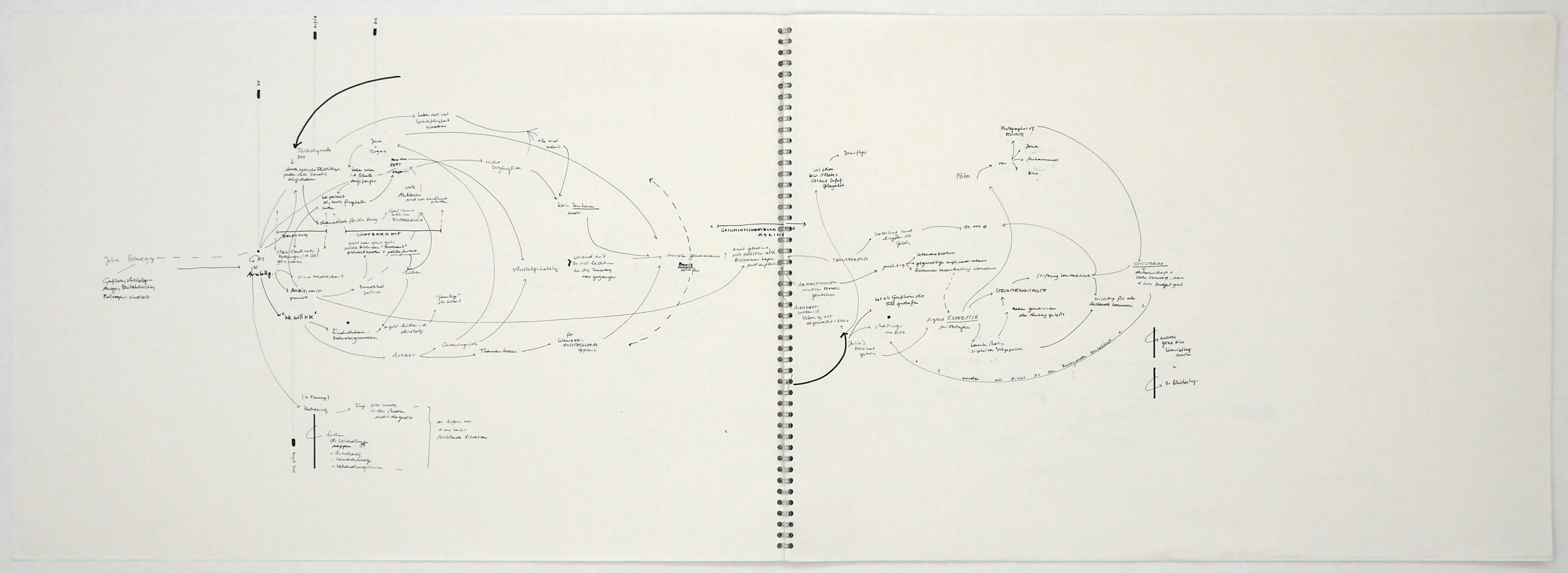
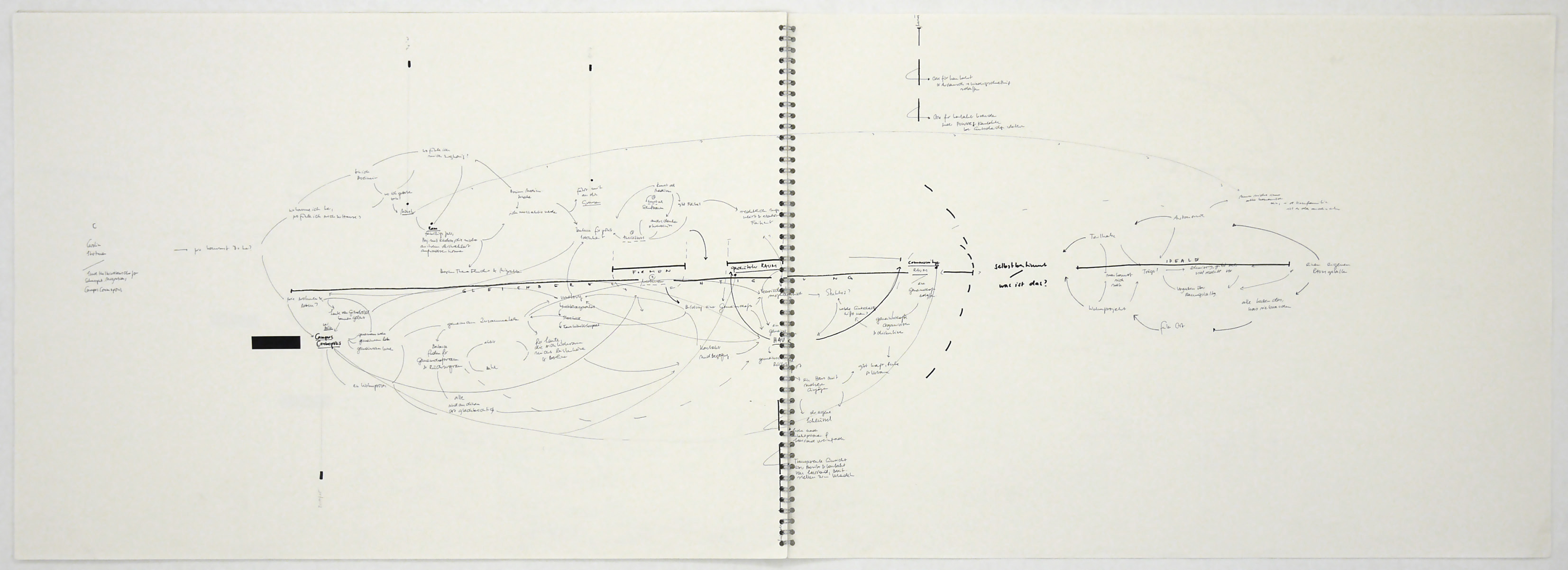
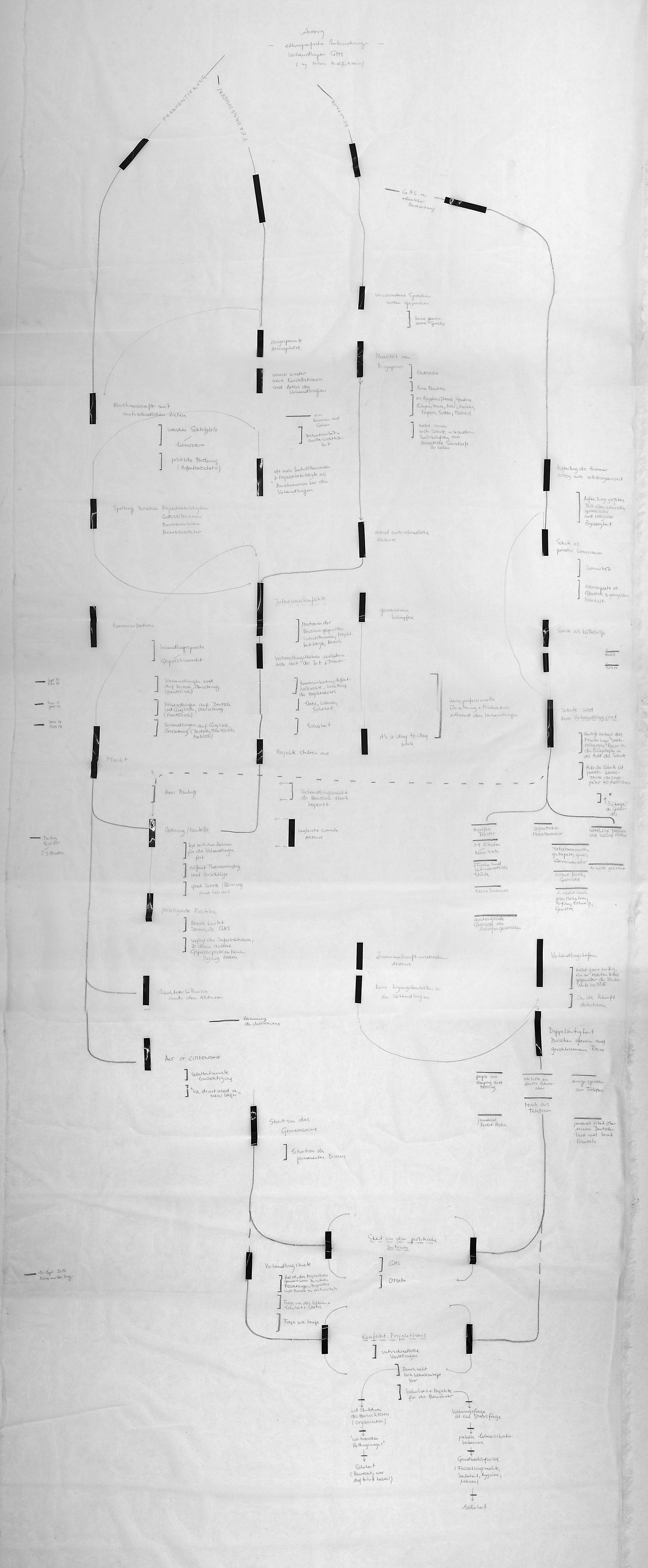
Connecting spaces
Im Rahmen der Konferenz »Zivilgesellschaft 4.0 – Geflüchtete und digitale Selbstorganisation« im Haus der Kulturen der Welt organisierte metroZones am 5. März 2016 einen Workshop unter dem Titel »Connecting spaces – digital, urban and translocal relations
& strategies«. Dort präsentierten Napuli Paul Langa, Muhammed Lamin Jadama, Muhammad Asif Syed und Diana Lucas-Drogan Mappings zu den Vernetzungen der Refugee-Bewegung.
Der Workshop
befasst sich mit unseren – Flüchtende/r oder nicht – Praktiken und Erfahrungen der Nutzung digitaler Technologien und ihrer Bedeutung im Alltag, Ausnahmezustand und städtischen Raum. Mit welchen Räumen, Orten, Gemeinschaften
und Wirklichkeiten verbinden wir uns und werden wir qua der Nutzung von Mobiltelefonen, Instant Messengers und anderen sozialen Medien verbunden? Wie hängen unsere digitalen Erfahrungen mit physischen Begegnungen und Beziehungen
von Angesicht zu Angesicht zusammen?
As part of the conference »Civil Society 4.0 – Refugees and Digital Self Organization« in the House of World Cultures, metroZones organized a workshop on 5 March 2016, under the title »Connecting spaces – digital, urban and translocal
relations & strategies«. Napuli Paul Langa, Muhammed Lamin Jadama, Muhammad Asif Syed and Diana Lucas-Drogan presented mappings about the networkings of the refugees' movement.
The workshop deals with our, refugee
and non-refugee, practices and experiences using digital technologies and their importance in everyday life, political emergencies and urban space. Which spaces, places, communities and realities are we connecting and connected
to through our use of mobile phones, instant messengers and other social media? How do our digital experiences relate to physical encounters and face-to-face relations?
Impressum
Imprint
»Berlin Field Recodings. Mapping Along the Refugee Complex« ist ein Projekt von
metroZones - Zentrum für städtische Angelegenheiten
www.metroZones.info
info@metroZones.info
Mitwirkende
In the System: Stephan Lanz (metroZones), Sarnath Banerjee, Muhammed Asif Syed, Barbara Wessel, Anna Hauke
Sur place: Anne Huffschmid, Christian Hanussek (beide metroZones), Laura Klatt, Jelka Plate
Wiederaufnahmeprobe: Jochen Becker (metroZones), Diana Lucas-Drogan, Muhammed Asif Syed, Marlene Rudloff
Übersetzung und Lektorat: Birgit Kolboske
Gestaltung: Christian Hanussek (metroZones)
Programmierung: Erwin Riedmann (metroZones)
© Copyright für die Kunstwerke bei den Künstlern
© Copyright für die Fotos bei Christian Hanussek und Anne Huffschmid (beide metroZones)
Gefördert aus Mitteln des Kulturamts Friedrichshain-Kreuzberg 
»Berlin Field Recodings. Mapping Along the Refugee Complex« is a project by
metroZones - Center for Urban Affairs
www.metroZones.info
info@metroZones.info
Participants
In the System: Stephan Lanz (metroZones), Sarnath Banerjee, Muhammed Asif Syed, Barbara Wessel, Anna Hauke
Sur place: Anne Huffschmid, Christian Hanussek (both metroZones), Laura Klatt, Jelka Plate
Wiederaufnahmeprobe: Jochen Becker (metroZones), Diana Lucas-Drogan, Muhammed Asif Syed, Marlene Rudloff
Translation and copy-editing: Birgit Kolboske
Design: Christian Hanussek (metroZones)
Programming: Erwin Riedmann (metroZones)
© Copyright for artwork owned by the artists
© Copyright for photography owned by Christian Hanussek and Anne Huffschmid (both metroZones)
Funded by the Kulturamt Friedrichshain-Kreuzberg 
Credits
Flowtimeflowtime-js.marcolago.com © 2012-2014 Marco Lago (Lizenz)Permission
is hereby granted, free of charge, to any person obtaining a copy of this software and associated documentation files (the "Software"), to deal in the Software without restriction, including without limitation the rights to use, copy,
modify, merge, publish, distribute, sublicense, and/or sell copies of the Software, and to permit persons to whom the Software is furnished to do so, subject to the following conditions:
The above copyright notice and this
permission notice shall be included in all copies or substantial portions of the Software.
THE SOFTWARE IS PROVIDED "AS IS", WITHOUT WARRANTY OF ANY KIND, EXPRESS OR IMPLIED, INCLUDING BUT NOT LIMITED TO THE WARRANTIES OF
MERCHANTABILITY, FITNESS FOR A PARTICULAR PURPOSE AND NONINFRINGEMENT. IN NO EVENT SHALL THE AUTHORS OR COPYRIGHT HOLDERS BE LIABLE FOR ANY CLAIM, DAMAGES OR OTHER LIABILITY, WHETHER IN AN ACTION OF CONTRACT, TORT OR OTHERWISE, ARISING
FROM, OUT OF OR IN CONNECTION WITH THE SOFTWARE OR THE USE OR OTHER DEALINGS IN THE SOFTWARE.
iScrolliscrolljs.com © 2014 Matteo Spinelli (Lizenz)Permission
is hereby granted, free of charge, to any person obtaining a copy of this software and associated documentation files (the "Software"), to deal in the Software without restriction, including without limitation the rights to use, copy,
modify, merge, publish, distribute, sublicense, and/or sell copies of the Software, and to permit persons to whom the Software is furnished to do so, subject to the following conditions:
The above copyright notice and this
permission notice shall be included in all copies or substantial portions of the Software.
THE SOFTWARE IS PROVIDED "AS IS", WITHOUT WARRANTY OF ANY KIND, EXPRESS OR IMPLIED, INCLUDING BUT NOT LIMITED TO THE WARRANTIES OF
MERCHANTABILITY, FITNESS FOR A PARTICULAR PURPOSE AND NONINFRINGEMENT. IN NO EVENT SHALL THE AUTHORS OR COPYRIGHT HOLDERS BE LIABLE FOR ANY CLAIM, DAMAGES OR OTHER LIABILITY, WHETHER IN AN ACTION OF CONTRACT, TORT OR OTHERWISE, ARISING
FROM, OUT OF OR IN CONNECTION WITH THE SOFTWARE OR THE USE OR OTHER DEALINGS IN THE SOFTWARE.
Flowtimeflowtime-js.marcolago.com © 2012-2014 Marco Lago (License)Permission
is hereby granted, free of charge, to any person obtaining a copy of this software and associated documentation files (the "Software"), to deal in the Software without restriction, including without limitation the rights to use, copy,
modify, merge, publish, distribute, sublicense, and/or sell copies of the Software, and to permit persons to whom the Software is furnished to do so, subject to the following conditions:
The above copyright notice and this
permission notice shall be included in all copies or substantial portions of the Software.
THE SOFTWARE IS PROVIDED "AS IS", WITHOUT WARRANTY OF ANY KIND, EXPRESS OR IMPLIED, INCLUDING BUT NOT LIMITED TO THE WARRANTIES OF
MERCHANTABILITY, FITNESS FOR A PARTICULAR PURPOSE AND NONINFRINGEMENT. IN NO EVENT SHALL THE AUTHORS OR COPYRIGHT HOLDERS BE LIABLE FOR ANY CLAIM, DAMAGES OR OTHER LIABILITY, WHETHER IN AN ACTION OF CONTRACT, TORT OR OTHERWISE, ARISING
FROM, OUT OF OR IN CONNECTION WITH THE SOFTWARE OR THE USE OR OTHER DEALINGS IN THE SOFTWARE.
iScrolliscrolljs.com © 2014 Matteo Spinelli (License)Permission
is hereby granted, free of charge, to any person obtaining a copy of this software and associated documentation files (the "Software"), to deal in the Software without restriction, including without limitation the rights to use, copy,
modify, merge, publish, distribute, sublicense, and/or sell copies of the Software, and to permit persons to whom the Software is furnished to do so, subject to the following conditions:
The above copyright notice and this
permission notice shall be included in all copies or substantial portions of the Software.
THE SOFTWARE IS PROVIDED "AS IS", WITHOUT WARRANTY OF ANY KIND, EXPRESS OR IMPLIED, INCLUDING BUT NOT LIMITED TO THE WARRANTIES OF
MERCHANTABILITY, FITNESS FOR A PARTICULAR PURPOSE AND NONINFRINGEMENT. IN NO EVENT SHALL THE AUTHORS OR COPYRIGHT HOLDERS BE LIABLE FOR ANY CLAIM, DAMAGES OR OTHER LIABILITY, WHETHER IN AN ACTION OF CONTRACT, TORT OR OTHERWISE, ARISING
FROM, OUT OF OR IN CONNECTION WITH THE SOFTWARE OR THE USE OR OTHER DEALINGS IN THE SOFTWARE.